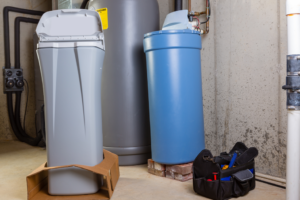
What kinds of problems do water softeners generally experience? Below, we’re going to discuss some of the most common water softener issues you might encounter in Naperville, Illinois.
Internal Clogs
One of the most common water softener problems is internal clogs. Clogs can form spontaneously due to a buildup of either hard water minerals or salt, generally forming in either the brine line of the water softener or the filter screen.
Unfortunately, internal clogs can have drastic negative effects on water softeners, sometimes preventing them from softening any water at all. This is why, if internal clogs present themselves, it’s important to remove them as quickly as possible.
While you might be able to remove internal clogs on your own, you are most likely better off utilizing the services of a local water conditioning company. Your local company will be familiar with all types of internal clogs and will be able to eliminate them in a timely and cost-efficient manner.
Worn Down Resin
In order to carry out the ion-exchange process, water softeners make use of resin beads. These beads will generally hold up over the entire lifespan of a water softener, but, in some cases, they can deteriorate prematurely. If they do give out early, you’ll be able to see them floating in your softener brine tank.
The good thing is that resin beads are fairly easy and inexpensive to replace. All you have to do is buy new ones and insert them into your brine tank. After doing so, your softener should be back in working order within a few hours.
The Development of Salt Bridges
In some cases, the lines within a water softener will become clogged. In other cases, the brine tank of the water softener will become clogged. When a brine tank becomes clogged, it’s usually because a salt bridge has formed within it.
Salt bridges can completely halt the operation of a water softener. This is why, if one exists in your softener, it’s important that you eradicate it as quickly as possible.
Fortunately, removing salt bridges is fairly simple. All you have to do is take a broom stick and poke around in your softener brine tank. Doing so carefully will break up the salt bridge and will allow your softener to perform like normal once again.
Lack of Salt
A big part of maintaining your water softener involves regularly adding salt to its brine tank. Water softeners need salt in order to carry out the ion-exchange process. If they don’t receive salt on a regular basis, they won’t be able to perform ion exchange, and will ultimately fail to soften the water that runs through the system.
The good news is that this isn’t a serious problem. All you have to do to fix it is to buy some softening salt and dump it into your brine tank. Within a day or less, your softener should be performing its function consistently once again.
In Need of Water Softener Repair in Naperville?
Is your water softener no longer performing as it should? In need of professional water softener repair in Naperville, Illinois? If so, DuPage Water Conditioning is the company to call.
We are well-versed in the inspection, maintenance, and repair of all types of water softening systems. Regardless of the problem your water softener is experiencing, our team of water conditioning specialists can fix it.
Contact us now to schedule an appointment!
